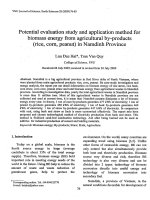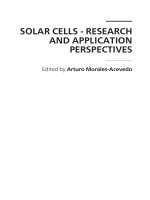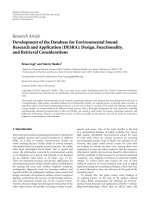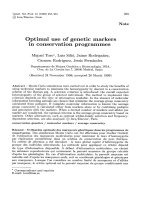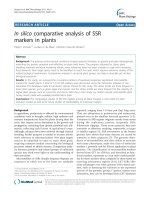Doctoral thesis summary of agriculture: Research and application of molecule markers in breeding salttolerant Bacthom 7 rice variety
Bạn đang xem bản rút gọn của tài liệu. Xem và tải ngay bản đầy đủ của tài liệu tại đây (310.41 KB, 10 trang )
MINISTRY OF EDUCATION
AND TRAINING
MINISTRY OF AGRICULTURE
AND RURAL DEVELOPMENT
VIETNAM ACADEMY OF AGRICULTURAL SCIENCES
DONG THI KIM CUC
“Research and application of molecule
markers in breeding salt-tolerant Bacthom 7
rice variety”
Major: Genetics and Breeding
Code: 62.62.01.11
DOCTORAL THESIS SUMMARY OF
AGRICULTURE
HaNoi - 2014
The Doctoral thesis was completed in:
VIETNAM ACADEMY OF AGRICULTURAL SCIENCES
Supervisos:
1. Assoc.Prof. Le Huy ham
2. Dr. Le Hung Linh
Objection1:
Objection2:
Objection3:
The Doctoral thesis is defelded at Institute Committee of PhD
Dissertation Examination:
VIETNAM ACADEMY OF AGRICULTURAL SCIENCES
At……day…….month ………… 2014
PhD thesis can be found at:
- Nationa Library of VietNam.
- Library of VietNam Academy of Agricultural Sciences
1
INTRODUCTION
1. Imperativeness of the thesis
Rice production and yield are significantly losses due to diseases and pests infestation and the
environmental impacts. Of these, the noticeable factor is salt-influenced to rice. The cultivated lands
have been affected from the salinity by 380 million ha, accounted for 1/3 total worldwide cultivated
areas.
Salt – affected lands is the main factor which has curbed to develop productivity of rice, and also
caused influence to food security in general. Hence, to reduce the salinity affect to the rice plant has
paid much attention to research [124].
To meet this demand, to generate the salinity tolerance rice variety is necessary work. It is
needed to explore the natural plant resource against salinity tolerance by either directly selecting or
by genetic selection, or marker assisted selection. Application of molecular markers may help to
identify the present of salinity tolerance gene(s), which is very useful for the breeder to select the
effective crossed combination. Hence, It would be accelerated to breed rice salinity tolerance,
shortened the selection time, and expenses and labour. As aforementioned, the topic entitled
“Application the molecular markers to improve salinity tolerance of Bac Thom 7”
2. Objectives
2.1. General objectives
Study on evaluating and developing some salinity tolerance of rice which derived from the the
IRRI and India, and some grown rice varieties in Vietnam were used in this thesis.
Applying marker assisted backcrossing to improve salinity tolerance of rice which are adapted
for the Red River Delta.
2.2. Specific Objectives
Identifying the salinity tolerance and phenotype of the rice lines which carrying the Saltol
locus (donor plant), imported from International Rice Research Institute, as well as selecting the
polularly grown rice cultivar were used as the receipient plant
Applying marker assisted backcrossing (MABC) to pyramid salinity tolerance Saltol locus
into Bac Thom 7, in order to generate the high quality rice variety with salinity tolerance for growing
the coastal areas in Red River Delta
3. Scientific and Practical Significance
3.1. Scientific Significance
2
Based on the successful archivements of application of marker assisted backcrossing to transfer
salinity tolerance QTL into other rice varieties will be widely applied for rice breeding to cope with
climate change in the foreseeable future.
Application of molecular breeding to combine with the traditional breeding to accelerate and identify
the salinity tolerance rice materials, to pyramid it into Bac Thom 7 which could help to overcome the
constrains of traditional breeding, especially with the heterzygote salinity tolerance QTL, reducing
the cost of experiments, shortening the time and rapidly applying in practice.
3.2. Practical Significance
The success of Saltol transfering into Bac Thom 7 based on molecular breeding will be widely
applied for rice molecular breeding.
The improved Saltol salinity tolerance of Bac Thom 7 lines would be selected and grown in a
larger scale, especially for the coastal areas in the north of Viet Nam, where the most adversed
influence from the climate change are.
The most other significance of the current thesis was to simultaneously develop the salinity
tolerance line/variety with the highest genetic background of the Bac Thom 7 and carried the Saltol
QTL. The newly improved lines would grow well in the salt areas.
4. Plant materials and the Scope study of thesis
4.1. Plant materials to study
The inbred rice varieties carrying the salinity tolerance (Saltol) which were imported from the
IRRI, and the inbred rice varieties are popularly grown in Vietnam, as well as using the related
molecular markers in the current study.
4.2. Places and time to conduct experiments
The experiments were carried out at the Molecular Biology Division, Agricultural Genetics
Institute, (Tu Liem, Hanoi); and the Center of Technological Exchange and Extension (Thanh Tri,
Hanoi), and Giao Thuy, Nam Dinh Province.
Time period: From 2010 to 2013
5. Significant Contribution
Application of molecular assisted backcrossing (MABC) is one of the initial research to
improve Bac Thom 7 with salinity tolerance for growing in the coastal areas of Red River Delta.
Applying MABC method which can be transferred the target gen/QTL in the other variety via
2-3 generations, while, traditional backcrossing has needed about 8 breeding generations
3
Application of molecular assisted backcrossing could pyramid the saltol into Bac thom 7
which also has carried the enough desire traits of Bac Thom 7, but can be grown in the salinity
affected areas upto 6 ‰
6. Structure of the Thesis
The current thesis was presented by 159 pages, of which included 25 Tables and 31 Fingures,
and separated into 4 chapters: Chapter I: An overview (50 pages), Chapter II: Materials and Methods
(15 pages); Chapter III: Results and Discussion (88 pages); Chapter IV: Conclusion and Suggestions
(2 pages). One hundred and ten literature references were used to cite for this thesis, in which there
are 23 Vietnamese references and 89 English reference and 16 link webpage were also used.
4
CHAPTER I
OVERVIEW AND SCIENTIFIC BACKGROUND
1.1. The adversed impacts from climate change to worldwide agricultural production and
Vietnam
1.1.1. Adversed effects from climate change to worldwide agricultural production
According to the report of FAO (2010), over 800 million ha of cultivated areas have been
affected by salinity and 20%, approximately 45 million ha, have been also affected due to salinity
penetration at different levels [38]. In Asia, if sea level rise will be at 1m, approximately 10.000 km2
cultivated and fishery areas will be influenced and become the salinity swarmp.
1.1.2. The effects of climate change to agricultural production in Vietnam
Vietnam is among the most influenced by sea level rise. The scientists reported that when the
sea level rise, some cultivated areas in Cuulong delta and Red River delta and some other coastal
delta will be inundated by sea water, and the sea level rise will be more increase, the most effected
areas will be Red River delta and Cuulong delta.
1.2. Salt affected land and salt affected areas in Vietnam
1.2.1. Salt affected land
The land consists of 50-60% ratio of argillaceous. The land shows high tight level and poor
absorbent level, tought patter, and chapped and difficult to do tillage.
Because the salt land is composing of much Na+ under the NaCl dissovel, thus, the pressure of
Na
2
SO4 endosmosis is so high that can be influenced to water and nutrition absobtion of the plant.
Also, neutral and alkali in salt land are causing low activation of the microoganism
1.2.2. General introduction of the rice field affected salinity in Vietnam
Accoring to Hoang Kim and Bien and Howeler (2003), in Vietnam, there are two larger rice
field affected salt is: Red River Delta included some sub-area such as Thai Binh, Hai Phong, Nam
Dinh, Ninh Binh, while approximately 1.8 to 2.1 millio ha of land have been affected by salinity
where are located in Ca Mau, Bac Lieu, Ben Tre, Kien Gian, Tien Giang, Tra Vinh and Soc Trang
Provinces. Most of cultivated land areas have been affected salinity and alum and flooding [4].
1.3. Genetic reseaches on salinity tolerance of rice
1.3.1. Mechanism of salinity tolerance of rice
• Phenomenom of salt prevention • Phenomenom of leaf to leaf patition
• Phenomenom of re-absorbance • Tolerance ability by the tissues
5
• Moving from root to bud •Dillution influence
1.3.2. Genetics of Salinity tolerance
1.3.2.1. Reseach on genetics of quantitative traits of salinity tolerance
According to Mishra et al (1998), the trait of salinity tolerance in plant is polygenic trait,
negligible causing effect from the parental plant (recipient plant) because these genes are not located
in the cytoplasm [72]. During development stage of rice, the plant height, and rice production under
salt affection are controlled by the additative genes (Mishra et al 1990)[73].
1.3.2.2. Research on salinity tolerance at molecular level
Based on the QTL mapping, salinity tolerance is controlled by multi-genes. Some markers such
as AFLP and STS have been used, the major gene has been identified and located on the chromosome
1 and named as Saltol. The QTL (quantitative trait loci) mapping has been applied in case of the
target gen has been controlled by many genes (example as salinity tolerance trait)
1.3.3. Expression of salinity tolerance of gene
Based on the morphological, physiological and biochemical characteristics of the experiment, we
have observed the present of Saltol-rice varieties and the sensitive rice varieties (without Saltol)
1.4. Molecular markers and their application
1.4.1. Molecular marker
Molecular markers (or DNA markers) are polymorphic markers. They are included the
molecular flow of DNA or the sequence information which are available and transiting in the
database or internet (for example, sequence of primers SSR, STS, RAPD, AFLP ).
1.4.2. Some popular markers-use
RFLP marker ((Restriction Fragment Length Polymorphism)
RAPD, AFLP, STS marker
SSR (Simple sequenced repeat)
1.4.3. Some applications of molecular markers
1.4.3.1. Study on genetic diversity
Research on genetic diversity is very important to help to evaluate the plant germplasm, animals and
use them more efficiency. Especially, it is possible to estimate the hererosis between the parents (the
pairs of parents carrying higher the genetic distance which could obtain more the heterosis properly.
1.4.3.2. Studying on genetic mapping
Application of molecular markers in QTL linkage mapping, has been applied the statistical analysis which
could identify the linkage between the markers and gen loci (Quantitative trait loci). QTL mapping included
6
the architecture of genome mapping which could be useful to search for relationship between the traits and
the polymorphic markers, and provide the close distance between QTL and markers, respectively.
1.4.3.3. Studying on plant breeding
Along with the advanced development of molecular breeding technologies, the breeders have paid more
attention to the issue as Marker assisted selection (MAS), has implied to use the markers that have linkage
with the interested QTL/genes in plant breeding programe
1.4.4. Application of Marker assisted backcrossing (MABC)
MABCis an a practical and efficient technique in transferring the interested QTL/gene into the elite rice
variety to generate the improved rice variety in a short time carrying the desire QTL/gene and attain
approximately 100% genetic background of the elite rice variety: The breeding programe may only
implement at the BC3 or even thought in BC2 generation, respectively.
1.5. Some archievements in improving rice salinity tolerance
1.5.1. Some results and archivements in research on rice salinity tolerance in the world
During the year 1977 to 1980, International Rice Research Institute (IRRI), was successfully
selected the good rice salinity tolerance such as IR42, IR4432-28-5, IR4595-4-1, IR463-22-2, and
IR9884-54-3 with the yield at 3,6 tones/ha. Gregorio et al (2002)[45] developed TCCP226-2-49-B-B-
3 rice cultivar with high salinity tolerance ability.
Some local rice varieties which were derived in the East Asia have often been high salinity tolerance
such as Nona Bokra (India), Pokkali (Sri Lanka), Getu (India), SR26B, Damodar, Cheriviruppu, Pat
and Solla (India), Ketumbar (Indonesia), Khao Seetha (Thailand). Some rice varieties were in the
template (subtropical countries) such as Harra (Spanish), Agami (Egypt), and Daeyabyeo (Korea).
Several Japonica rice varieties such as Moroberekan have high salinity tolerance, which were
origined in the affected salt areas. This variety has been researched and used as the donor plant
(salinity tolerance) and population mapping (Kim et al, 2009)[55]. The rice varieties were Oryza
glaberrima, which are mostly grown in the West African show lower salinity tolerance ability to
compare with the rice varieties (Oryza sativa) (Awala và cs, 2010)[2].
Recently, in 2013, researchers in IRRI have successfully developed the high-super salt
tolerance that could be very useful for the farmers to grow this rice cultivar in the affected salt areas
such as the coastal areas.
1.5.2. Application of molecular markers in improving salinity tolerance of rice
The fine mapping of Saltol QTL was made on the chromosome 1 by the researcher groups
(Gregorio 1997; Bonille et al 2002; and Niones 2004) which explained about 40-65% salinity
7
tolerance in rice [44][28][85]. Mohammadi – Nejad et al (2010) used 33 SSR polymorphic markers
on the chromosome 1 “Saltol QTL” in order to identify the linkage and the utinity of the markers for
rice breeding [76].
1.5.3. Some results and archivements of research on salinity tolerance of rice in Vietnam
1.5.3.1. Use of the SSR markers which have tightly linked to Saltol QTL in rice breeding
Application of molecular markers and anther culture to improve salinity tolerance of rice were
conducted, total 72 rice lines were generated by anther culture (Lang et al, 2008). Also, Buu et al
(2000) used 30 SSR markers to map the salinity tolerance trait in the F3 generation that including 257
segregation population from the crossed between IR28/Đoc Phung.
1.5.3.2. Improving the rice salinity tolerance
Đo Huu At (2005) made mutation by Coban (Co
60
) to generate CM1, CM5, [1]. Also, Dang
Minh Tam et al (2003), reported that 10 rice line were developed from the local and high yield rice
cultivars, shown a medium salt tolerance (3-5 point). Moreover, they showed high regenerative
percentage in the NaCl culture at 1,0 and 1,5% [35]. Ngo Dinh Thuc (2006) applied the anther culture
technique to create 8 soma variation liné from the OM576, IR64, Basmati and VD20 which could
withstand salinity tolerace at 5 level at the test of rice seeding with EC = 12 dS/m [19].
1.5.3.3. Screening salinity tolerance of rice
From 1992 – 1995, Institute of Southeast Agriculture and Science reported that 14 potential
rice cultivars involving salinity tolerance were selected as the following: Nep ao Gia; Trang Diep;
Mong Chim; Mong Chim Roi; and Nep Bo Rieng [8]. Also, Cuulong Rice Research Institute has
reported to attain 30 rice lines with promising in salinity tolerance as from 2000 to present. The Field
Crops Research documented that M6 is a salinity tolerance which obtained from the crossed Bau Hai
Phong/1548 during the year of 2001-2005.
8
CHAPTER III
MATERIALS, CONTENTS AND METHODS
2.1. Materials
The rice materials included:
Total 14 rice lines/varieties carrying Saltol QTL salinity tolerance were imported from
IRRI and some popularly grown rice varieties in Red River Delta
Chemical argents and research facilities:
SSR markers used: 447 markers
Research instruments: Experimental tools of Agricultural Genetics Institute
2.2. Areas to conduct experiments
The Laboratory of Molecular Biology Division-Agricultural Genetics Insititute. Tuliem-Hanoi
The Net house and paddy fields conducted for experiment at the Center of Technology
Exchange and Extension, Vinh Quynh, Thanh Tri, Hanoi
Experiments for evaluation of growth and development of the imported rice lines/varieties
were conducted in two provinces: Nam Dinh and Hanoi
Perious to implement: From 2010 to 2013
2.3. Contents
2.3.1. Content 1: Research, evaluation of the salinity tolerance and agronomical traits, rice yield and
some sub-traits involving in rice yield of the Salton-lines/varieties imported from IRRI and some
popularly grown in the Red River Delta. It has been an important for further research on rice salinity
tolerance for the coastal areas in North Vietnam
2.3.2. Content 2: Application of marker assisted backcrossing to transfer the Saltol QTL into
Bacthom 7, an elite rice cultivar
2.3.3. Content 3: Evaluating some main agronomical traits and several components involving in rice
yield traits, salinity tolerance level, rice quality of the lines carrying Saltol QTL in the net house and
the paddy field test
2.4. Methods
* MABC (Marker Assisted Backcrossing) to improve salinity tolerance of rice
2.4.1. Methods to conduct field test
2.4.2. Methods for evaluation of salinity tolerance of rice: Screening in the artificial conditions.
2.4.3. Methods to implement experiments in the laboratory
